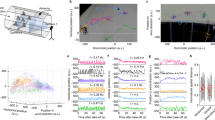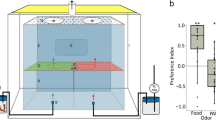Abstract
Any flying animal leaves behind a wake of turbulent air. Thus, a closely tailing neighbor may be buffeted by complex aerodynamic forces. We report here that pairs of tethered locusts (Locusta migratoria) flying in tandem in a wind tunnel, couple their wing-beats to one another. Wind-receptive hairs on the rear partner's head provide the main sensory input that produces the coupling. The phase angle of coupling depends upon the distance between the individuals. By phase-coupling to a forward neighbor's wake, a locust may turn this turbulence to its own aerodynamic advantage. Moreover, within a large swarm local groups of locusts may fly in a functionally integrated manner.
Similar content being viewed by others
References
Bacon J, Möhl B (1983) The tritocerebral commissure giant (TCG) wind-sensitive interneurone in the locust. I. Its activity in straight flight. J Comp Physiol 150:439–452
Baker PS, Gewecke M, Cooter RJ (1981) The natural flight of the migratory locust, Locusta migratoria L. III. Wing-beat frequency, flight speed and attitude. J Comp Physiol 141:233–237
Baker PS, Gewecke M, Cooter RJ (1984) Flight orientation of swarming Locusta migratoria. Physiol Entomol 9:247–252
Berger M (1972) Formationsflug ohne Phasenbeziehung der Flügelschläge. J Ornithol 113:161–169
Brodsky AK (1991) Vortex formation in the tethered flight of the peacock butterfly Inachis io L. (Lepidoptera, Nymphalidae) and some aspects of insect flight evolution. J Exp Biol 161:77–95
Brodsky AK, Ivanov VD (1984) The role of vortices in insect flight. Zool Zhurn Moskau 63(2): 197–208 (in Russian)
Camhi JM, Tom W, Volman S (1978) The escape behavior of the cockroach Periplaneta americana. II. Detection of natural predators by air displacement. J Comp Physiol 128:203–212
Cooter RJ (1989) Swarm flight behavior in flies and locusts. In: Goldsworthy GJ, Wheeler CH (eds) Insecl flight. CRC Press, Boca Raton, pp 165–203
Gettrup E (1962) Thoracic proprioceptors in the flight system of locusls. Nature 193:498–499
Gewecke M (1972) Antennen und Stirn-Scheitelhaare von Locusta migratoria L. als Luftströmungs-Sinnesorgane bei der Flugsleuerung. J Comp Physiol 80:57–94
Gewecke M (1975) The influence of Ihe air-current sense organs on Ihe flighl behaviour of Locusta migratoria. J Comp Physiol 103:79–95
Gewecke M, Kutsch W (1979) Developmenl of flighl behaviour in maturing adults of Locusta migratoria: I. Flight performance and wing-stroke parameters. J Insect Physiol 25:249–253
Gewecke M, Philippen J (1978) Control of horizontal flight-course by air-current sense organs in Locusta migratoria. Physiol Entomol 3:43–52
Grodnitsky DL, Morozov PP (1992) Flow visualization experiments on tethered flying green lacewings Chrysopa dasyptera. J Exp Biol 169:143–163
Gunn DL, Perry FC, Seymour WG, Telford TM, Wright EN, Yeo D (1948) Behaviour of the Desert locust in relation to aircraft spraying. Anti-Locust Bull 3:1–70
Hainsworth FR (1987) Precision and dynamics of positioning by Canada geese flying in formation. J Exp Biol 128:445–462
Higdon JJL, Corrsin S (1978) Induced drag of a bird flock. Am Natur 112:727–744
Horsmann U, Heinzel H-G, Wendler G (1983) The phasic influence of self-generated air current modulations on the locust flight motor. J Comp Physiol 150:427–438
Hummel D (1983) Aerodynamic aspects of formation flight in birds. J Theor Biol 104:321–347
Kutsch W (1989) Development of the flight motor pattern. In: Goldsworthy GJ, Wheeler CH (eds) Insect flight. CRC Press, Boca Raton, pp 51–73
Kutsch W, Stevenson P (1981) Time-correlated flights of juvenile and mature locusts: a comparison between free and tethered animals. J Insect Physiol 27:455–459
Libersat F (1992) Modulation of flight by the giant interneurons of the cockroach. J Comp Physiol A 170:379–392
Lissaman PBS, Shollenberger CA (1970) Formation flight of birds. Science 168:1003–1005
Nachtigall W (1970) Phasenbeziehungen der Flügelschläge von Gänsen während des Verbandflugs in Keilformation. Z Vergl Physiol 67:414–422
Nachtigall W (1986) Bewegungsphysiologie; Laufen-Schwimmen-Fliegen. Hdb Zool Vol IV, Arthropoda: Insecta. de Gruyter, Berlin
Norberg UM (1990) Vertebrate flight. Springer, Berlin
Pearson KG, Ramirez JM (1990) Influence of input from the forewing stretch receptors on motoneurones in flying locusts. J Exp Biol 151:317–340
Pearson KG, Reye DN, Robertson RM (1983) Phase-dependent influences of wing stretch receptors on flight rhythm in the locust. J Neurophysiol 49:1168–1181
Pflüger H-J, Tautz J (1982) Air movement sensitive hairs and interneurons in Locusta migratoria. J Comp Physiol 145:369–380
Rainey RC (1976) Flight behaviour and features of the atmospheric environment. In: Rainey RC (ed) Insect flight. Blackwell, Oxford, pp 75–112
Rainey RC (1989) Migration and meteorology. Clarendon, Oxford
Rayner JMV (1979) A new approach to animal flight mechanics. J Exp Biol 80:17–54
Reichert H, Rowell CHF (1986) Neuronal circuits controlling flight in the locust: how sensory information is processed for motor control. Trends Neurosci 9:281–283
Snodgrass RE (1929) The thoracic mechanism of a grasshopper, and its antecedents. Smiths Misc Coll 82:1–112
Waldron I (1968) The mechanism of coupling of the locust flight oscillator to oscillatory inputs. Z Vergl Physiol 57:331–347
Weis-Fogh T (1956a) Biology and physics of locust flight. II. Flight performance of the desert locust (Schistocerca gregaria). Phil Trans R Soc London B 239:459–510
Weis-Fogh T (1956b) Biology and physics of locust flight. IV. Notes on sensory mechanisms in locust flight. Phil Trans R Soc London B 239:553–584
Wendler G (1974) The influence of proprioceplive feedback on locust flight co-ordination. J Comp Physiol 88:173–200
Wilson DM, Weis-Fogh T (1962) Patterned activily of co-ordinated motor units, studied in flying locusts. J Exp Biol 39:643–667
Wilson DM, Wyman RJ (1965) Motor output patterns during random and rhythmic stimulation of locust thoracic ganglia. Biophys J 5:121–143
Author information
Authors and Affiliations
Rights and permissions
About this article
Cite this article
Kutsch, W., Camhi, J. & Sumbre, G. Close encounters among flying locusts produce wing-beat coupling. J Comp Physiol A 174, 643–649 (1994). https://doi.org/10.1007/BF00217385
Accepted:
Issue Date:
DOI: https://doi.org/10.1007/BF00217385




